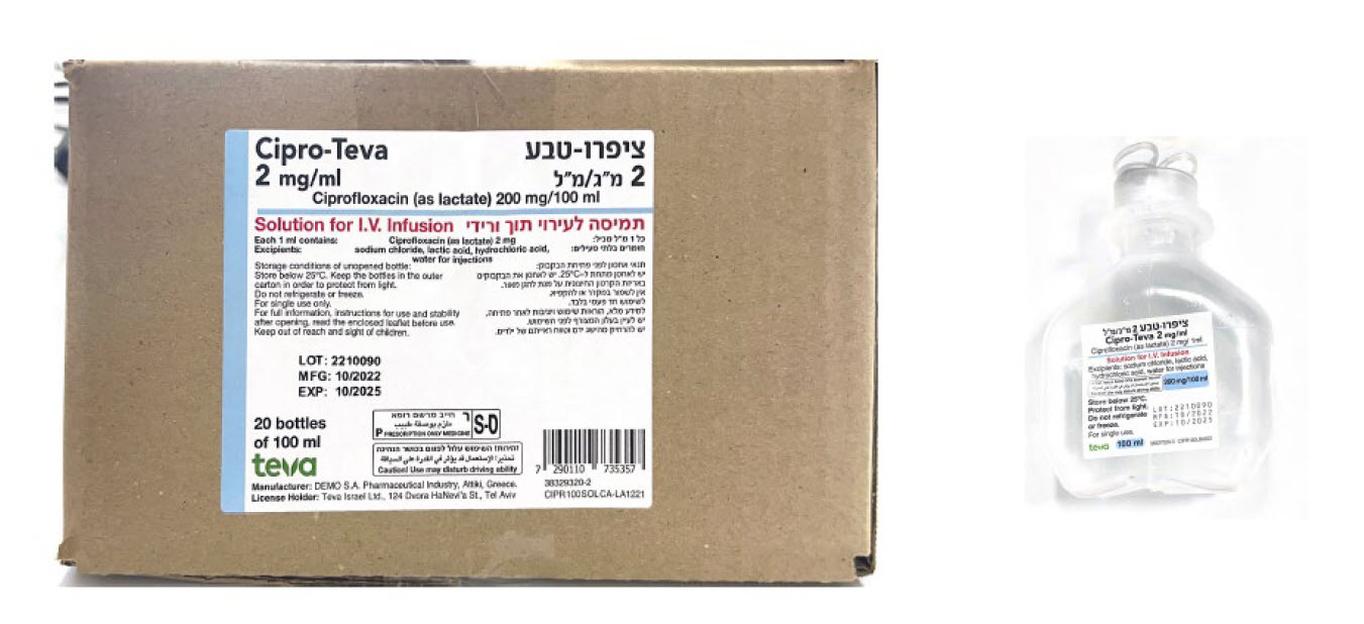Quest for the right Drug

ציפרו-טבע ® 2 מ"ג/מ"ל CIPRO-TEVA ® 2 MG/ML (CIPROFLOXACIN AS LACTATE)
תרופה במרשם
תרופה בסל
נרקוטיקה
ציטוטוקסיקה
צורת מתן:
תוך-ורידי : I.V
צורת מינון:
תמיסה לאינפוזיה : SOLUTION FOR INFUSION
עלון לרופא
מינוניםPosology התוויות
Indications תופעות לוואי
Adverse reactions התוויות נגד
Contraindications אינטראקציות
Interactions מינון יתר
Overdose הריון/הנקה
Pregnancy & Lactation אוכלוסיות מיוחדות
Special populations תכונות פרמקולוגיות
Pharmacological properties מידע רוקחי
Pharmaceutical particulars אזהרת שימוש
Special Warning עלון לרופא
Physicians Leaflet
Interactions : אינטראקציות
4.5 Interaction with other medicinal products and other forms of interaction Effects of other products on ciprofloxacin: Drugs known to prolong QT interval Ciprofloxacin, like other fluoroquinolones, should be used with caution in patients receiving drugs known to prolong QT interval (e.g., Class IA and III anti-arrhythmics, tricyclic antidepressants, macrolides, antipsychotics) (see section 4.4). Probenecid Probenecid interferes with renal secretion of ciprofloxacin. Co-administration of probenecid and ciprofloxacin increases ciprofloxacin serum concentrations. Effects of ciprofloxacin on other medicinal products: Tizanidine Tizanidine must not be administered together with ciprofloxacin (see section 4.3). In a clinical study with healthy subjects, there was an increase in serum tizanidine concentration (Cmax increase: 7-fold, range: 4 to 21-fold; AUC increase: 10-fold, range: 6 to 24-fold) when given concomitantly with ciprofloxacin. Increased serum tizanidine concentration is associated with a potentiated hypotensive and sedative effect. Methotrexate Renal tubular transport of methotrexate may be inhibited by concomitant administration of ciprofloxacin, potentially leading to increased plasma levels of methotrexate and increased risk of methotrexate-associated toxic reactions. The concomitant use is not recommended (see section 4.4). Theophylline Concurrent administration of ciprofloxacin and theophylline can cause an undesirable increase in serum theophylline concentration. This can lead to theophylline-induced side effects that may rarely be life-threatening or fatal. During the combination, serum theophylline concentrations should be checked and the theophylline dose reduced as necessary (see section 4.4). Other xanthine derivatives On concurrent administration of ciprofloxacin and caffeine or pentoxifylline (oxpentifylline), raised serum concentrations of these xanthine derivatives were reported. Phenytoin Simultaneous administration of ciprofloxacin and phenytoin may result in increased or reduced serum levels of phenytoin such that monitoring of drug levels is recommended. Cyclosporin A transient rise in the concentration of serum creatinine was observed when ciprofloxacin and cyclosporin-containing medicinal products were administered simultaneously. Therefore, it is frequently (twice a week) necessary to control the serum creatinine concentrations in these patients. Vitamin K antagonists Simultaneous administration of ciprofloxacin with a vitamin K antagonist may augment its anticoagulant effects. The risk may vary with the underlying infection, age and general status of the patient so that the contribution of ciprofloxacin to the increase in INR (international normalised ratio) is difficult to assess. The INR should be monitored frequently during and shortly after co-administration of ciprofloxacin with a vitamin K antagonist (e.g., warfarin, acenocoumarol, phenprocoumon, or fluindione). Duloxetine In clinical studies, it was demonstrated that concomitant use of duloxetine with strong inhibitors of the CYP450 1A2 isozyme, such as fluvoxamine, may result in an increase of AUC and Cmax of duloxetine. Although no clinical data are available on a possible interaction with ciprofloxacin, similar effects can be expected upon concomitant administration (see section 4.4). Ropinirole It was shown in a clinical study that concomitant use of ropinirole with ciprofloxacin, a moderate inhibitor of the CYP450 1A2 isozyme, results in an increase of Cmax and AUC of ropinirole by 60% and 84%, respectively. Monitoring of ropinirole-related side effects and dose adjustment as appropriate is recommended during and shortly after co- administration with ciprofloxacin (see section 4.4). Lidocaine It was demonstrated in healthy subjects that concomitant use of lidocaine containing medicinal products with ciprofloxacin, a moderate inhibitor of CYP450 1A2 isozyme, reduces clearance of intravenous lidocaine by 22%. Although lidocaine treatment was well tolerated, a possible interaction with ciprofloxacin associated with side effects may occur upon concomitant administration. Clozapine Following concomitant administration of 250 mg ciprofloxacin with clozapine for 7 days, serum concentrations of clozapine and N-desmethylclozapine were increased by 29% and 31%, respectively. Clinical surveillance and appropriate adjustment of clozapine dosage during and shortly after co-administration with ciprofloxacin are advised (see section 4.4). Sildenafil Cmax and AUC of sildenafil were increased approximately twofold in healthy subjects after an oral dose of 50 mg given concomitantly with 500 mg ciprofloxacin. Therefore, caution should be used prescribing ciprofloxacin concomitantly with sildenafil, taking into consideration the risks and the benefits. Agomelatine In clinical studies, it was demonstrated that fluvoxamine, as a strong inhibitor of the CYP450 1A2 isoenzyme, markedly inhibits the metabolism of agomelatine resulting in a 60-fold increase of agomelatine exposure. Although no clinical data are available for a possible interaction with ciprofloxacin, a moderate inhibitor of CYP450 1A2, similar effects can be expected upon concomitant administration (see section 4.4). Zolpidem Co-administration of ciprofloxacin may increase blood levels of zolpidem, concurrent use is not recommended.

שימוש לפי פנקס קופ''ח כללית 1994
לא צוין
תאריך הכללה מקורי בסל
לא צוין
הגבלות
לא צוין
מידע נוסף
